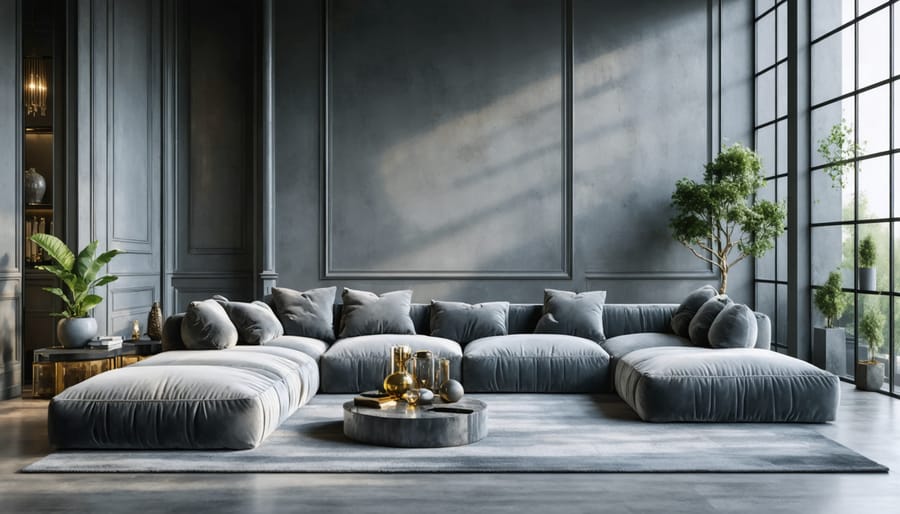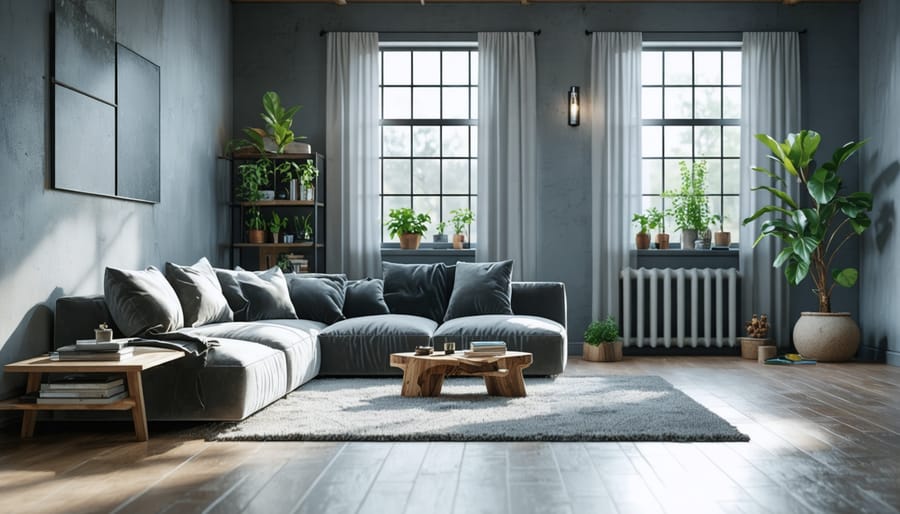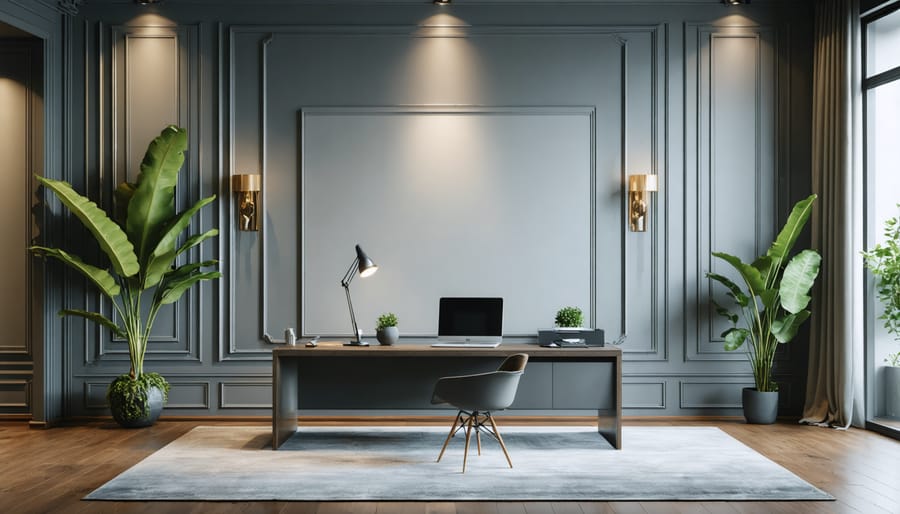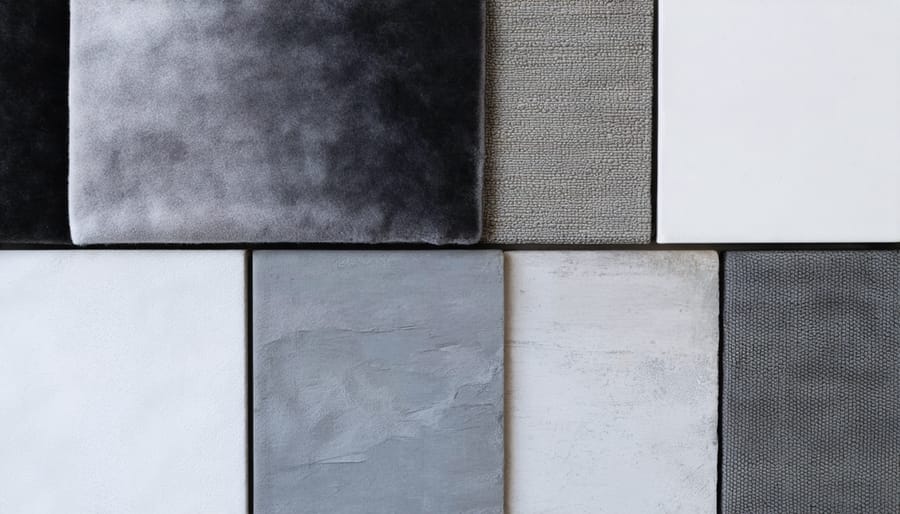
Grey’s profound psychological impact on interior spaces transcends mere aesthetic appeal, operating as a powerful tool for creating sophisticated, balanced environments. As the bridge between black and white, grey embodies neutrality and sophistication, making it a cornerstone of modern interior design psychology. Professional designers harness grey’s versatility to establish calm, focused atmospheres in corporate settings while simultaneously crafting warm, inviting residential spaces that exude elegance.
This adaptable neutral carries unique psychological properties that influence mood, perception, and behavior. In commercial spaces, grey promotes concentration and professionalism, while in homes, it creates a sanctuary-like atmosphere that reduces stress and enhances relaxation. Understanding grey’s psychological effects enables designers to strategically incorporate various shades – from soft pewter to deep charcoal – to achieve specific emotional responses and spatial perceptions.
Far more than a trend, grey’s psychological benefits in interior design represent a scientifically-backed approach to creating spaces that support both emotional wellbeing and functional objectives.
Grey acts as a powerful stabilizing force in interior design, creating spaces that feel inherently balanced and emotionally grounded. This neutral shade works as a psychological anchor, helping to calm the mind and reduce visual stress in both residential and commercial environments. By incorporating various tones of grey, from soft pewter to deep charcoal, designers can establish a sense of permanence and reliability within a space.
The color’s natural ability to bridge stark contrasts makes it particularly effective in creating harmonious transitions between different design elements. In high-traffic areas, grey provides a reassuring backdrop that helps maintain emotional equilibrium, while in private spaces, it fosters an atmosphere of quiet contemplation and inner peace.
Studies have shown that grey environments can help regulate mood swings and promote mental clarity, making it an excellent choice for workspaces and meditation rooms. When properly balanced with other elements, grey creates a foundation of stability that allows both residents and visitors to feel centered and composed, contributing to the overall psychological well-being of the space’s occupants.
Grey’s widespread use in professional environments stems from its inherent ability to create an atmosphere of competence and reliability. Corporate offices, healthcare facilities, and modern retail spaces frequently incorporate grey as it promotes focus and reduces visual distractions, allowing employees and clients to concentrate on tasks at hand. The color’s neutrality makes it particularly effective in commercial settings where maintaining a consistent brand image is crucial while providing a sophisticated backdrop that doesn’t compete with corporate logos or signage.
Studies have shown that grey environments can enhance productivity and decision-making capabilities, making it a strategic choice for conference rooms and collaborative spaces. Its versatility in combining with accent colors allows businesses to create distinct zones while maintaining a cohesive professional appearance throughout their facilities. Additionally, grey’s association with stability and permanence helps establish trust and credibility, essential qualities for businesses looking to make lasting impressions on clients and stakeholders.
Grey serves as an exceptional foundation for any interior design palette, offering unparalleled versatility and sophistication. As a neutral backdrop, it creates the perfect canvas to blend classic and contemporary styles while maintaining visual harmony. Whether you’re working with cool or warm undertones, grey acts as a stabilizing force that can anchor bold accent colors or create subtle, monochromatic schemes.
In modern design, light greys work particularly well with crisp whites and natural materials, creating an airy, sophisticated atmosphere. Medium greys pair beautifully with jewel tones, adding depth without overwhelming the space. Darker greys, meanwhile, can create dramatic effects when combined with metallics or serve as a sophisticated alternative to black.
The key to successfully using grey as a foundation lies in understanding its undertones. Blue-greys create a cooler, more contemporary feel, while warm greys with brown or taupe undertones foster a more welcoming, traditional atmosphere. This adaptability makes grey an ideal choice for both residential and commercial spaces, allowing for easy updates and style transitions without requiring a complete design overhaul.

Grey’s versatility shines when paired with carefully selected accent colors. For a sophisticated and calming atmosphere, combine light grey with soft blues or sage greens – these combinations work exceptionally well in bedrooms and home offices. Medium grey serves as an excellent backdrop for vibrant yellows or coral pinks, instantly adding warmth and energy to living spaces.
Dark charcoal grey creates dramatic impact when paired with crisp white or cream, perfect for modern commercial spaces. For a luxurious feel, combine any shade of grey with metallic accents like gold, silver, or copper. These metallic elements can be incorporated through fixtures, artwork, or decorative accessories.
Nature-inspired combinations, such as grey with deep forest green or ocean blue, bring the outdoors in while maintaining a professional aesthetic. For those seeking a bold statement, pair grey with deep purple or burgundy – these combinations work particularly well in formal dining rooms or executive offices.
Remember that the undertones in your chosen grey (warm or cool) should guide your accent color selection to ensure a cohesive look throughout the space.
Grey’s versatility shines particularly bright in living spaces, where it creates an atmosphere of sophisticated comfort. Light grey walls serve as an ideal backdrop for family gatherings, promoting a sense of calm while maintaining an open, airy feel. When used on larger furniture pieces like sofas or sectionals, mid-tone greys offer practical durability while conveying stability and reliability – perfect for high-traffic family areas.
In modern living rooms, charcoal grey accent walls can anchor the space and create depth, while lighter grey textiles and accessories maintain balance. The color’s inherent neutrality allows for seamless seasonal decor changes and accommodates various color accents, making it a practical choice for evolving family needs.
For maximum psychological benefit, combine warm greys with natural textures like wood and wool to create an inviting atmosphere that encourages relaxation and connection. Cool greys pair beautifully with metallic accents and clean lines, promoting a sense of order and mental clarity – essential qualities for spaces where families spend significant time together.
In professional environments, grey serves as a sophisticated foundation that promotes focus and productivity. Home offices benefit from lighter grey tones, which create a calm yet energizing atmosphere that aids concentration without causing visual fatigue. The color’s inherent neutrality minimizes distractions while providing a professional backdrop for video calls and meetings.
Commercial spaces frequently incorporate grey in varying shades to establish authority and reliability. Conference rooms often feature deep charcoal accents to convey stability and confidence, while creative agencies might opt for warmer grey tones to balance professionalism with innovation. Reception areas particularly benefit from grey’s versatility, as it can be paired with brand colors while maintaining a welcoming yet distinguished atmosphere.
When designing professional spaces, consider using grey in combination with strategic lighting to enhance its psychological benefits. Matte grey finishes reduce glare on screens, while metallic grey accents can add subtle dynamism to otherwise modest environments. This thoughtful application of grey helps create spaces that support both individual focus and collaborative engagement.

In bedrooms and personal spaces, grey serves as an excellent foundation for creating serene, restful environments. Light grey walls can promote a sense of calm and tranquility, making it easier to unwind after a long day. When paired with soft textures like plush carpets or velvet upholstery, grey becomes particularly effective at crafting a cocoon-like atmosphere that encourages relaxation and quality sleep.
Consider using warmer grey tones in north-facing bedrooms to counteract cooler natural light, while cooler greys work well in spaces that receive ample sunlight. Layer different grey shades through bedding, curtains, and decorative elements to add depth without disrupting the room’s peaceful ambiance. For children’s bedrooms, lighter greys provide a versatile backdrop that can grow with them, while darker charcoal accents can add sophistication to master suites.
To maintain balance, incorporate natural elements like wooden furniture or potted plants, preventing the space from feeling too clinical or monotonous. This combination creates an ideal environment for rest and rejuvenation.
Grey’s versatility shines through thoughtful texture and material selection, adding depth and visual interest to any space. When working with modern interior fabrics and textures, consider layering different materials to create a rich, multidimensional environment. Soft velvet upholstery can provide warmth and luxury, while sleek metallic accents add contemporary sophistication. Natural materials like stone and wood introduce organic elements that ground the space and create balance.
For walls, consider textured wallpapers or techniques like lime washing to add subtle movement. Woven textiles, such as wool throws and chunky knit pillows, bring tactile comfort to seating areas. Glass and mirror elements can reflect light and make spaces feel more open, while matte finishes on furniture pieces reduce glare and create a sophisticated atmosphere.
Mix smooth and rough textures strategically – perhaps combining polished concrete floors with plush area rugs, or pairing silk curtains with textured grasscloth wall coverings. This thoughtful contrast prevents grey spaces from feeling flat or monotonous.

Lighting plays a crucial role in how grey tones are perceived in interior spaces. Natural daylight can dramatically transform grey walls and furnishings throughout the day, creating dynamic environments that shift from cool and calming in the morning to warm and intimate during sunset hours. When working with grey interiors, it’s essential to consider both the direction and intensity of natural light entering the space.
For artificial illumination, modern lighting solutions can help maintain the desired mood regardless of the time of day. Warm-toned LED lights can soften cooler greys and create a welcoming atmosphere, while cooler lighting temperatures can enhance the sophisticated and contemporary feel of warmer grey tones. Consider incorporating multiple light sources at different heights to create depth and prevent grey spaces from appearing flat or monotonous. Task lighting becomes particularly important in grey rooms to ensure functionality while maintaining the room’s aesthetic appeal.
Grey’s versatility and sophistication make it an invaluable tool in interior design, offering both practical and psychological benefits. As we’ve explored, this neutral powerhouse creates environments that feel balanced, professional, and calming while providing the perfect backdrop for both bold accents and subtle design elements. The key to success lies in understanding how different shades of grey interact with lighting, space dimensions, and complementary colors to achieve the desired emotional response.
Remember that warm greys foster comfort and intimacy, ideal for living spaces and bedrooms, while cooler greys enhance focus and productivity, perfect for offices and workspaces. The strategic use of grey can make spaces appear larger, more elegant, and more cohesive while maintaining a timeless appeal that transcends passing trends.
To maximize grey’s potential in your space, consider the room’s purpose, natural lighting conditions, and existing architectural elements. Whether used as a dominant color or an accent, grey’s ability to create sophisticated, well-balanced interiors while promoting psychological well-being makes it an enduring choice for modern design schemes.